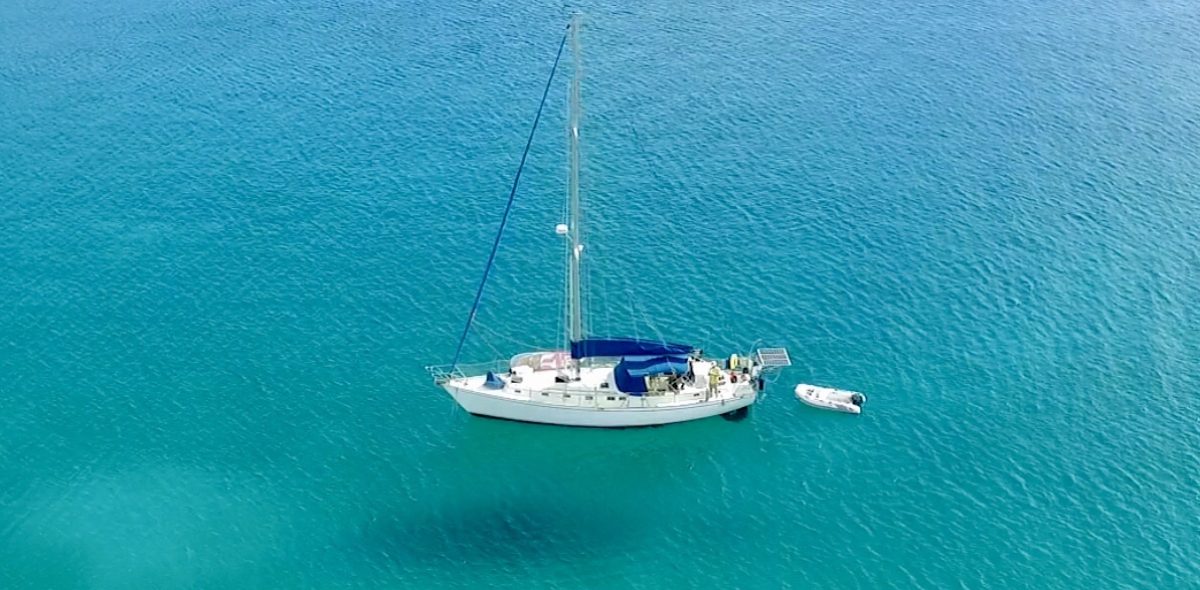Things have been a bit crazy here and we have been ignoring the blog. That’s changing now that we are in the water and running. What have we been up to?
Engine installation:
The motor mounts took a bit of time to get right which delayed us about 10 days. By the time the motor was all bolted in and ready to splash, it was Tuesday, August 16th. All looked good. The mechanic finished all the controls and tidied up the engine compartment.
Sea Trial #1
On Thursday August 18th, Sarah and I took the day off for the first sea trial. We were super excited to have our baby in the water. It had been 9 weeks in the yard! We were joined by our mechanic Vince and our broker Andrew.
Remember the early Star Trek’s where Captain Kirk was pushing the warp engines and the enterprise would almost shake apart, explode and/or unexpectedly disintegrate? Yeah, well Perspective was that Enterprise on Thursday. The engine ran perfectly, but there was a horrific vibration that seriously made us worry. It started at 1200 RPM and built to a crescendo by WOT(wide open throttle). It was so bad, we couldn’t talk in the cockpit. Suffice it to say, we headed back to the yard.
Pulling Perspective round 2
 The yard was kind enough to immediately pull the boat. Everything “looked” ok; The prop shaft spun true, the cutlass bearings appeared fine and the prop looked perfect. Suspecting the prop, we pulled it and sent it to the prop shop and stayed in the sling all night.
The yard was kind enough to immediately pull the boat. Everything “looked” ok; The prop shaft spun true, the cutlass bearings appeared fine and the prop looked perfect. Suspecting the prop, we pulled it and sent it to the prop shop and stayed in the sling all night.

The next morning, the prop shop reported that the prop was perfect. Back in the water she goes.
Sea Trial #2
Friday mid-day, Our good friend and Captain Jesper took her back out for sea trial with no improvement. We started to suspect cavitation as a contributing factor…
Frustrated and tired of the yard dirt and treatment, we motored back to our home slip.
The Research Project
Andrew chased down Doug Peterson who didn’t have any input. He also spoke to the yard and Chuck Driscoll remembered commissioning the KP’s. They were notorious for cavitation and many had the skeg reshaped to improve water flow to the prop. Theory #1: The skeg was disrupting water flow.
I exercised my google skills and brushed up on my fluid dynamics. I discovered a cause can be the spacing between the propeller and the skeg. At this point I remembered that the propeller was too close to the skeg to insert the normal zincs. Theory #2: The propeller is too close to the skeg.
Vince assured us that the prop is in the same spot as it was previously and was leaning toward Theory #1.
Pulling Perspective round 3
Vince convinced the yard to give us another pull. I was out of town and Jesper generously offered to move her to the yard and babysit the inspection. We pulled her again on Wednesday, August 24th and the inspections began. 

While there was still debate, everyone agreed that the prop was not centered. We ordered a prop saver which would add an insurance to the shaft. Also, the skeg shaping had already been done, so scratch theory #1. Back in the water to await the prop saver!
Sea Trial #3
I arrived back in town Thursday night. Jesper and I took the boat out with the prop saver installed. What a difference an inch makes! Keep your mind out of the gutter.
The original vibration started around 1200 RPM’s and now started around 2500. The total vibration was about 75% less–not gone, but definite improvement. It’s apparent that moving the prop helped and cavitation is a large part of, if not the whole problem.
I’m still not satisfied, so investigating a larger spacer or a 4 blade prop…. That said, it’s good enough to go to Catalina next weekend!!!!
Other projects completed:
- Fix forward head which is a vacu-flush which stopped vacu’ing. Shitty job. Enough said.


- Fix dead sump pump–thanks Jesper !
- Fix fridge drain, not draining.
- Fix engine room blower.
- Fix propane locker drain.
- Fix propane system. New regulator and solenoid–thanks Jesper!
- Climbed the mast and replaced bulb in steaming light with LED. First of many.
- Replace stern light–thanks Jesper!
- Got the dinghy motor running. Runs like a champ!
























































